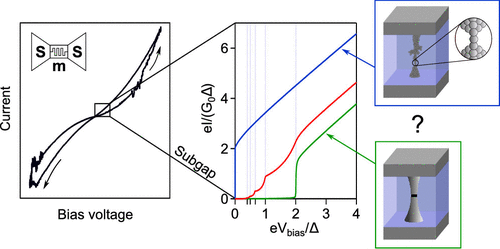当前位置:
X-MOL 学术
›
Nano Lett.
›
论文详情
Our official English website, www.x-mol.net, welcomes your
feedback! (Note: you will need to create a separate account there.)
Breaking the Quantum PIN Code of Atomic Synapses.
Nano Letters ( IF 9.6 ) Pub Date : 2020-01-13 , DOI: 10.1021/acs.nanolett.9b04617 Tímea Nóra Török 1, 2 , Miklós Csontos 1, 3 , Péter Makk 1 , András Halbritter 1, 2
Nano Letters ( IF 9.6 ) Pub Date : 2020-01-13 , DOI: 10.1021/acs.nanolett.9b04617 Tímea Nóra Török 1, 2 , Miklós Csontos 1, 3 , Péter Makk 1 , András Halbritter 1, 2
Affiliation

|
Atomic synapses represent a special class of memristors whose operation relies on the formation of metallic nanofilaments bridging two electrodes across an insulator. Due to the magnifying effect of this narrowest cross section on the device conductance, a nanometer-scale displacement of a few atoms grants access to various resistive states at ultimately low energy costs, satisfying the fundamental requirements of neuromorphic computing hardware. However, device engineering lacks the complete quantum characterization of such filamentary conductance. Here we analyze multiple Andreev reflection processes emerging at the filament terminals when superconducting electrodes are utilized. Thereby, the quantum PIN code, i.e., the transmission probabilities of each individual conduction channel contributing to the conductance of the nanojunctions, is revealed. Our measurements on Nb2O5 resistive switching junctions provide profound experimental evidence that the onset of the high conductance ON state is manifested via the formation of truly atomic-sized metallic filaments.
中文翻译:

打破原子突触的量子PIN码。
原子突触代表一类特殊的忆阻器,其操作依赖于跨过绝缘体的两个电极之间桥接的金属纳米丝的形成。由于该最窄横截面对器件电导的放大作用,几个原子的纳米级位移以最终较低的能源成本准许进入各种电阻状态,从而满足了神经形态计算硬件的基本要求。但是,器件工程缺乏这种丝状电导的完整量子表征。在这里,我们分析了利用超导电极时,灯丝端子处出现的多个Andreev反射过程。由此,量子PIN码,即,每个单独的传导通道对纳米结的电导作出贡献的传输概率,被揭示。我们对Nb2O5电阻性开关结的测量提供了深刻的实验证据,表明通过形成真正原子尺寸的金属细丝可以证明高电导率ON状态的发生。
更新日期:2020-01-14
中文翻译:

打破原子突触的量子PIN码。
原子突触代表一类特殊的忆阻器,其操作依赖于跨过绝缘体的两个电极之间桥接的金属纳米丝的形成。由于该最窄横截面对器件电导的放大作用,几个原子的纳米级位移以最终较低的能源成本准许进入各种电阻状态,从而满足了神经形态计算硬件的基本要求。但是,器件工程缺乏这种丝状电导的完整量子表征。在这里,我们分析了利用超导电极时,灯丝端子处出现的多个Andreev反射过程。由此,量子PIN码,即,每个单独的传导通道对纳米结的电导作出贡献的传输概率,被揭示。我们对Nb2O5电阻性开关结的测量提供了深刻的实验证据,表明通过形成真正原子尺寸的金属细丝可以证明高电导率ON状态的发生。










































 京公网安备 11010802027423号
京公网安备 11010802027423号